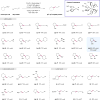Metallaphotoredox-catalysed sp(3)-sp(3) cross-coupling of carboxylic acids with alkyl halides
- PMID: 27535536
- PMCID: PMC5695702
- DOI: 10.1038/nature19056
Metallaphotoredox-catalysed sp(3)-sp(3) cross-coupling of carboxylic acids with alkyl halides
Abstract
In the past 50 years, cross-coupling reactions mediated by transition metals have changed the way in which complex organic molecules are synthesized. The predictable and chemoselective nature of these transformations has led to their widespread adoption across many areas of chemical research. However, the construction of a bond between two sp(3)-hybridized carbon atoms, a fundamental unit of organic chemistry, remains an important yet elusive objective for engineering cross-coupling reactions. In comparison to related procedures with sp(2)-hybridized species, the development of methods for sp(3)-sp(3) bond formation via transition metal catalysis has been hampered historically by deleterious side-reactions, such as β-hydride elimination with palladium catalysis or the reluctance of alkyl halides to undergo oxidative addition. To address this issue, nickel-catalysed cross-coupling processes can be used to form sp(3)-sp(3) bonds that utilize organometallic nucleophiles and alkyl electrophiles. In particular, the coupling of alkyl halides with pre-generated organozinc, Grignard and organoborane species has been used to furnish diverse molecular structures. However, the manipulations required to produce these activated structures is inefficient, leading to poor step- and atom-economies. Moreover, the operational difficulties associated with making and using these reactive coupling partners, and preserving them through a synthetic sequence, has hindered their widespread adoption. A generically useful sp(3)-sp(3) coupling technology that uses bench-stable, native organic functional groups, without the need for pre-functionalization or substrate derivatization, would therefore be valuable. Here we demonstrate that the synergistic merger of photoredox and nickel catalysis enables the direct formation of sp(3)-sp(3) bonds using only simple carboxylic acids and alkyl halides as the nucleophilic and electrophilic coupling partners, respectively. This metallaphotoredox protocol is suitable for many primary and secondary carboxylic acids. The merit of this coupling strategy is illustrated by the synthesis of the pharmaceutical tirofiban in four steps from commercially available starting materials.
Conflict of interest statement
The authors declare no competing financial interests. Readers are welcome to comment on the online version of this article at
Figures




Similar articles
-
Carboxylic Acids as Adaptive Functional Groups in Metallaphotoredox Catalysis.Acc Chem Res. 2022 Dec 6;55(23):3481-3494. doi: 10.1021/acs.accounts.2c00607. Epub 2022 Nov 22. Acc Chem Res. 2022. PMID: 36472093 Free PMC article.
-
Synthetic and Mechanistic Implications of Chlorine Photoelimination in Nickel/Photoredox C(sp3)-H Cross-Coupling.Acc Chem Res. 2021 Feb 16;54(4):988-1000. doi: 10.1021/acs.accounts.0c00694. Epub 2021 Jan 29. Acc Chem Res. 2021. PMID: 33511841 Free PMC article.
-
Direct arylation of strong aliphatic C-H bonds.Nature. 2018 Aug;560(7716):70-75. doi: 10.1038/s41586-018-0366-x. Epub 2018 Aug 1. Nature. 2018. PMID: 30068953 Free PMC article.
-
Ni-Catalyzed C-C Couplings Using Alkyl Electrophiles.Top Curr Chem (Cham). 2016 Oct;374(5):66. doi: 10.1007/s41061-016-0067-6. Epub 2016 Aug 31. Top Curr Chem (Cham). 2016. PMID: 27580894 Review.
-
Secondary alkyl halides in transition-metal-catalyzed cross-coupling reactions.Angew Chem Int Ed Engl. 2009;48(15):2656-70. doi: 10.1002/anie.200803611. Angew Chem Int Ed Engl. 2009. PMID: 19173365 Review.
Cited by
-
Redox-neutral decarboxylative coupling of fluoroalkyl carboxylic acids via dual metal photoelectrocatalysis.Chem Sci. 2024 Oct 12;15(44):18497-503. doi: 10.1039/d4sc06057a. Online ahead of print. Chem Sci. 2024. PMID: 39430939 Free PMC article.
-
Synthesis of thioethers, arenes and arylated benzoxazoles by transformation of the C(aryl)-C bond of aryl alcohols.Chem Sci. 2020 Apr 15;11(29):7634-7640. doi: 10.1039/d0sc01229g. Chem Sci. 2020. PMID: 34094141 Free PMC article.
-
A practical catalytic reductive amination of carboxylic acids.Chem Sci. 2020 Aug 12;11(35):9494-9500. doi: 10.1039/d0sc02271c. Chem Sci. 2020. PMID: 34123174 Free PMC article.
-
Carboxylic Acids as Adaptive Functional Groups in Metallaphotoredox Catalysis.Acc Chem Res. 2022 Dec 6;55(23):3481-3494. doi: 10.1021/acs.accounts.2c00607. Epub 2022 Nov 22. Acc Chem Res. 2022. PMID: 36472093 Free PMC article.
-
Deaminative Arylation of Amino Acid-derived Pyridinium Salts.Org Lett. 2019 Sep 20;21(18):7356-7360. doi: 10.1021/acs.orglett.9b02643. Epub 2019 Aug 29. Org Lett. 2019. PMID: 31464131 Free PMC article.
References
-
- de Meijere A, Diederich F. Metal-catalyzed cross-coupling reactions. Wiley-VCH; 2004.
-
- Geist E, Kirschning A, Schmidt T. sp3-sp3 Coupling reactions in the synthesis of natural products and biologically active molecules. Nat Prod Rep. 2014;31:441. - PubMed
-
- Haas D, Hammann JM, Greiner R, Knochel P. Recent developments in Negishi cross-coupling reactions. ACS Catal. 2016;6:1540–1552.
-
- Phapale VB, Cárdenas DJ. Nickel-catalysed Negishi cross-coupling reactions: scope and mechanisms. Chem Soc Rev. 2009;38:1598. - PubMed
Publication types
MeSH terms
Substances
Grants and funding
LinkOut - more resources
Full Text Sources
Other Literature Sources
Miscellaneous

